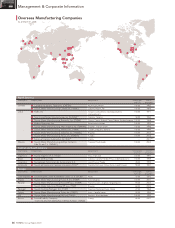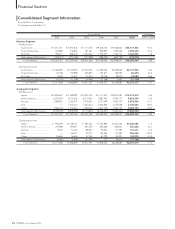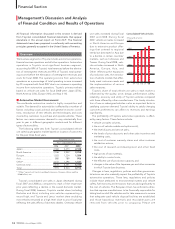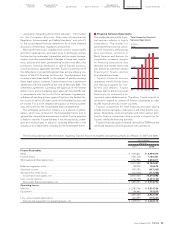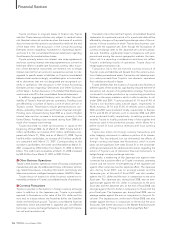Toyota 2008 Annual Report Download - page 78
Download and view the complete annual report
Please find page 78 of the 2008 Toyota annual report below. You can navigate through the pages in the report by either clicking on the pages listed below, or by using the keyword search tool below to find specific information within the annual report.
76 TOYOTA •Annual Report 2008 •
Financial Section
Toyota continues to originate leases to finance new Toyota
vehicles. These leasing activities are subject to residual value
risk. Residual value risk could arise when the lessee of a vehicle
does not exercise the option to purchase the vehicle at the end
of the lease term. See discussion in the Critical Accounting
Estimates section regarding “Investment in Operating Leases”
and note 2 to the consolidated financial statements regarding
the allowance for residual values losses.
Toyota primarily enters into interest rate swap agreements
and cross currency interest rate swap agreements to convert its
fixed-rate debt to variable-rate functional currency debt. A por-
tion of the derivative instruments are entered into to hedge
interest rate risk from an economic perspective and are not de-
signated to specific assets or liabilities on Toyota’s consolidated
balance sheet and accordingly, unrealized gains or losses relat-
ed to derivatives that are not designated are recognized cur-
rently in operations. See discussion in the Critical Accounting
Estimates section regarding “Derivatives and Other Contracts
at Fair Value”, further discussion in the Market Risk Disclosures
section and note 20 to the consolidated financial statements.
In addition, aggregated funding costs can affect the prof-
itability of Toyota’s financial services operations. Funding costs
are affected by a number of factors, some of which are not in
Toyota’s control. These factors include general economic con-
ditions, prevailing interest rates and Toyota’s financial strength.
Funding costs increased during fiscal 2007 as a result of higher
interest rates and an increase in borrowings, primarily in the
United States. Funding costs increased during fiscal 2008 as a
result of an increase in borrowings.
Toyota launched its credit card business in Japan at the
beginning of fiscal 2002. As of March 31, 2007, Toyota had 6.1
million cardholders, an increase of 0.7 million cardholders com-
pared with March 31, 2006, and as of March 31, 2008, Toyota
had 6.6 million cardholders, an increase of 0.5 million cardhold-
ers compared with March 31, 2007. Corresponding to the
increase in cardholders, the credit card receivables at March 31,
2007 increased by ¥30.0 billion from March 31, 2006 to ¥201.2
billion. The credit card receivables at March 31, 2008 increased
by ¥24.5 billion from March 31, 2007 to ¥225.7 billion.
■Other Business Operations
Toyota’s other business operations consist of housing, including the
manufacture and sale of prefabricated homes; information technol-
ogy related businesses, including information technology and
telecommunications, intelligent transport systems, GAZOO; others.
Toyota does not expect its other business operations to
materially contribute to Toyota’s consolidated results of operations.
■Currency Fluctuations
Toyota is sensitive to fluctuations in foreign currency exchange
rates. In addition to the Japanese yen, Toyota is principally
exposed to fluctuations in the value of the U.S. dollar and the
euro and, to a lesser extent, the Australian dollar, the Canadian
dollar and the British pound. Toyota’s consolidated financial
statements, which are presented in Japanese yen, are affected
by foreign currency exchange fluctuations through both transla-
tion risk and transaction risk.
Translation risk is the risk that Toyota’s consolidated financial
statements for a particular period or for a particular date will be
affected by changes in the prevailing exchange rates of the cur-
rencies in those countries in which Toyota does business com-
pared with the Japanese yen. Even though the fluctuations of
currency exchange rates to the Japanese yen can be substan-
tial, and, therefore, significantly impact comparisons with prior
periods and among the various geographic markets, the trans-
lation risk is a reporting consideration and does not reflect
Toyota’s underlying results of operations. Toyota does not
hedge against translation risk.
Transaction risk is the risk that the currency structure of
Toyota’s costs and liabilities will deviate from the currency struc-
ture of sales proceeds and assets. Transaction risk relates primari-
ly to sales proceeds from Toyota’s non-domestic operations
from vehicles produced in Japan.
Toyota believes that the location of its production facilities in
different parts of the world has significantly reduced the level of
transaction risk. As part of its globalization strategy, Toyota has
continued to localize production by constructing production
facilities in the major markets in which it sells its vehicles. In cal-
endar 2006 and 2007, Toyota produced 61.1% and 61.4% of
Toyota's non-domestic sales outside Japan, respectively. In
North America, 54.7% and 57.2% of vehicles sold in calendar
2006 and 2007 were produced locally, respectively. In Europe,
70.7% and 64.0% of vehicles sold in calendar 2006 and 2007
were produced locally, respectively. Localizing production
enables Toyota to locally purchase many of the supplies and
resources used in the production process, which allows for a
better match of local currency revenues with local currency
expenses.
Toyota also enters into foreign currency transactions and
other hedging instruments to address a portion of its transac-
tion risk. This has reduced, but not eliminated, the effects of
foreign currency exchange rate fluctuations, which in some
years can be significant. See notes 20 and 21 to the consolidat-
ed financial statements for additional information regarding the
extent of Toyota’s use of derivative financial instruments to
hedge foreign currency exchange rate risks.
Generally, a weakening of the Japanese yen against other
currencies has a positive effect on Toyota’s revenues, operating
income and net income. A strengthening of the Japanese yen
against other currencies has the opposite effect. The Japanese
yen, during fiscal 2007, was on average weaker and the
Japanese yen, at the end of fiscal 2007, was also weaker,
against the U.S. dollar and the euro in comparison to the prior
fiscal year. The Japanese yen, during fiscal 2008, was on aver-
age stronger against the U.S. dollar in comparison to the prior
fiscal year and the Japanese yen, at the end of fiscal 2008, was
stronger against the U.S. dollar in comparison to the end of the
prior fiscal year. The Japanese yen, during fiscal 2008, was on
average weaker against the euro in comparison to the prior fis-
cal year. The Japanese yen, at the end of fiscal 2008, was also
weaker against the euro in comparison to the end of the prior
fiscal year. See further discussion in the Market Risk Disclosures
section regarding “Foreign Currency Exchange Rate Risk”.
■
■


